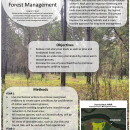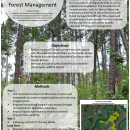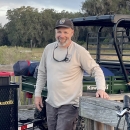States
Georgia, South CarolinaPinckney Island and Harris Neck NWR’s, administered by the Savannah Coastal Refuges Complex, propose to use mechanical selective removal of trees and shrubs to reduce hazardous fuels, control invasive species invasive species
An invasive species is any plant or animal that has spread or been introduced into a new area where they are, or could, cause harm to the environment, economy, or human, animal, or plant health. Their unwelcome presence can destroy ecosystems and cost millions of dollars.
Learn more about invasive species , and improve forest habitat for resident, migratory, and imperiled wildlife species. The selective removal of trees and shrubs, in this instance, is defined as the cutting and/or removing of trees by various techniques, such as chipping, mulching, and chainsaw felling. This is an existing refuge use but is being currently reviewed as the National Wildlife Refuge System Improvement Act of 1997 and US Fish and Wildlife Service Compatibility Policy requires re-evaluation of non-priority uses every 10 years. The 2011 Savannah Coastal Refuges Complex Comprehensive Conservation Plan and Environmental Assessment found this use to be compatible with the mission of these NWR’s.
This use would be conducted primarily within established pine and mixed pine hardwood stands scattered across the landscape of both Pinckney Island and Harris Neck NWR’s. In addition to hazardous fuel reduction and invasive Chinese tallow tree control, these areas would be overall improved for a variety of wildlife species found here. These include painted bunting (Passerina ciris), Bachman’s sparrow (Peucaea aestivalis), various woodpeckers, tricolored bat (Perimyotis subflavus), gopher tortoise (Gopherus polyphemus), eastern diamondback rattlesnake (Crotalus adamanteus), and many others.
The Compatibility Determinations and Environmental Action Statements related to the proposed forest management action, as well as informational posters on both Pinckney Island and Harris Neck NWR's projects may be viewed by clicking on the "Library" link below.
UPDATE 08/21/2025
Pinckney Island NWR: Mechanical operations on Pinckney Island were completed in May on a total of 645 acres. The main objectives for this work (wildfire hazard fuel reduction, invasive species control, improved wildlife habitat) were met and the overall forest response to this project has been as expected. Numerous areas where dense fuels and invasive species were prevalent last Summer are now growing in annual plants and native grasses that benefit many wildlife species. A variety of pollinators have been particularly noticeable in these areas.
The value of this project for wildfire hazard fuel control was recently on display when lightning struck a pine tree near Shell Point, causing a 30 acre wildfire. Due to fuel reduction efforts and increased access through the mechanical work, the wildland fire team was able to quickly control the fire and actually use the fire to improve habitat quality in the area.
The next phase of this project is the spot application of selective herbicide. This work will be completed in late August - September, as weather allows. This will involve work crews with backpack sprayers walking through the entire area that was mechanically treated and treating stump sprouts and seedlings of all Chinese tallow tree and some sweetgum. This work will provide further control of invasive species, improve wildlife habitat, reduce wildfire hazard fuels, and prepare the area for long-term maintenance through frequent prescribed fires.
Harris Neck NWR: Mechanical operations on Harris Neck were completed in April ton a total of 304 acres. The main objectives for this work (wildfire hazard fuel reduction, invasive species control, improved wildlife habitat) were met and the overall forest response has been as expected. Numerous areas where dense fuels were present last Summer are now growing in variety of native ground cover plants, including blazing star and sandhill milkweed.
The next phase of this project is the spot application of selective herbicide. This work will be completed beginning 08/25/2025 and should last for about two weeks, weather dependent. This will involve a field crew of five with backpack sprayers walking through the entire 304 acres that were mechanically treated and treating stump sprouts and seedlings of invasive trees. This work will provide further control of invasive species, improve wildlife habitat, reduce wildfire hazard fuels, and prepare the area for long-term maintenance through frequent prescribed fires.
UPDATE 03/05/2025
Pinckney Island NWR: Mulching operations continue at Pinckney Island NWR with about 435 acres treated so far. A total of 645 acres will be treated when finished. The project is planned for completion no later than April 30, 2025. There are three primary objectives of this important project. First, this action is aimed at reducing wildfire hazards by lowering the amount of fuel in the middle layers of the forest. This makes wildfires and prescribed burns much more manageable across the landscape while also improving wildlife habitat. Second, mulching aids in management of invasive species. Chinese tallow tree, and extremely invasive, non-native species found throughout the refuge, displaces native trees and negatively impacts water quality in freshwater wetlands. Finally, completion of this project will improve access for long-term forest management, longleaf pine reforestation, and create a more open environment for refuge visitors. Wildlife species expected to benefit from this work include brown-headed nuthatch, red-headed woodpecker, a variety of sparrows, fox squirrel, and others.
Harris Neck NWR: Mulching operations continue at Harris Neck NWR with about 220 acres treated so far. A total of 304 acres will be treated when finished. The project is planned for completion no later than April 30, 2025. There are three primary objectives of this important project. First, this action is aimed at reducing wildfire hazards by lowering the amount of fuel in the middle layers of the forest. This makes wildfires and prescribed burns much more manageable across the landscape. Second, mulching aids in reducing invasive plant species impacts. Chinese tallow tree, mimosa, Chinaberry, and other species present a challenge to forest management and control of these species makes for better habitat. The third and final objective of this project is to promote a diverse understory of native grasses and broadleaf plants through removal of loblolly pines and some areas of overly dense oaks. Encouraging native ground cover plants, such as broomsedge, little bluestem, Indiangrass, blazing star, sandhill milkweed, and other species ensures quality habitat for painted bunting, gopher tortoise, monarch butterfly, white-tailed deer, and other priority wildlife species.







